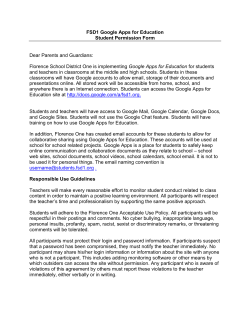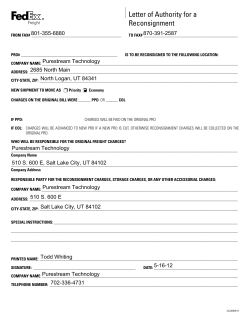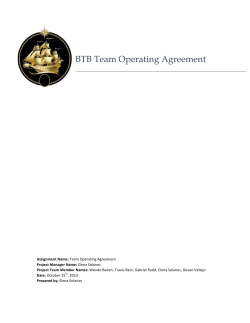
G u i d
National Weather Service Guidebook Table of Contents INTRODUCTION ................................................................................................................................................. 2 WHAT IS GOOGLE EARTH? .................................................................................................................................. 2 KML AND KMZ FILES…WHAT IS THE DIFFERENCE? ................................................................................................. 3 HOW CAN I USE GE PRO? ................................................................................................................................... 3 HOW DO I STARTUP GE PRO?.............................................................................................................................. 3 WHERE DO I FIND DATA TO OVERLAY IN GE PRO? ................................................................................................... 4 HOW DO I VIEW DATA IN A FOLDER? ..................................................................................................................... 6 HOW DO I IMPORT MY OWN DATA?...................................................................................................................... 8 HOW DO I IMPORT SHAPEFILES?........................................................................................................................... 9 HOW DO I DRAW TORNADO TRACKS? .................................................................................................................. 11 HOW DO I EXPORT MY DATA INTO GOOGLE EARTH KML/KMZ FILES? ...................................................................... 13 WHERE DO I FIND RADAR AND WARNING POLYGONS? ............................................................................................ 14 HOW CAN I USE GE PRO AS A SITUATIONAL AWARENESS TOOL? .............................................................................. 15 HOW CAN I VERIFY WARNINGS USING GE PRO? .................................................................................................... 16 HOW DO I GET HAIL SWATH AND ROTATIONAL TRACKS INTO GE PRO? ...................................................................... 17 GE PRO RESOURCES ......................................................................................................................................... 18 1 INTRODUCTION Google Earth Pro holds much potential in enhancing National Weather Service (NWS) operations and services. The purpose of this guide book is to provide you with an overview of some Google Earth Pro features and utilities that are beneficial to the NWS operational environment. A summary of features, general instructions, and links to additional resources are included. WHAT IS GOOGLE EARTH? Google Earth is a graphical interface that allows you to explore the surface of the Earth. The program utilizes multiple sources of information including satellites, aerial surveys (15K – 30K ft.) The imagery is scanned at 1800 DPI, color balanced, and combined into a mosaic for the area. Then layers of information are added like, country/state borders, roads, schools, parks, etc. The imagery for any specific area is updated every 1 to 3 years! NOAA has negotiated an Enterprise License agreement with Google for use of the Google Earth program (Pro version) as well as the Google Maps API. NWS Offices will be allowed to install the software where appropriate. Use of Google Earth material on National Weather Service websites and in presentations for public display is allowed as long as the Google logo is visible in the lower right corner of the image. KML, the Google Earth file format, was approved as an open standard by the Open Geospatial Consortium on April 14, 2008. As such, it will now be maintained by the OGC. The OGC is an international consortium of more than 345 companies, government agencies, research organizations, and universities participating in a consensus process to develop publicly available geospatial standards. Because KML was approved by the OGC, developers now have a standard approach for using KML to code and share visual geographic content in existing or future web-based online maps and 3D geospatial browsers like Google Earth. 2 KML AND KMZ FILES…WHAT IS THE DIFFERENCE? KML stands for Keyhole Markup Language. Keyhole was the name of the application before Google bought it and added their own features and larger databases. If you understand HTML/XML you will have little problem understanding the syntax of KML. You can learn about KML from the Google Earth KML tutorial…http://code.google.com/apis/kml/documentation/kml_tut.html. KMZ stands for KML-Zipped. It is the default format for KML because it is a compressed version of the file. One of the more powerful features of KMZ is that it allows any images you use - say custom icons, or images in your descriptions - to be zipped up within the KMZ file. That way you can share these details without having to reference the files through some link to the Internet. For KMZ files without images, the file size will be much smaller than the equivalent KML file. HOW CAN I USE GE PRO? This data rich environment enhances situational awareness because it provides more meaning to the data. Multiple georeferenced layers such as infrastructure, geographical features, geo-political boundaries, locations of businesses, spotters, etc. give meteorological data more context. Google Earth can be utilized to enhance internal operations and situational awareness. Radar & Satellite (single image and loop) Watch & Warning Polygons Storm Reports Spotter calls / Verification Risk & Impact Analysis / Decision Tool Flood & Flash Flood (AHPS, QPF, FFG, etc.) Observations (METAR, AHPS, etc.) Equipment Status (radar, METAR) HOW DO I STARTUP GE PRO? 1. Click on Google Earth Pro icon: 2. You will be prompted to login: (If prompted for a license key, refer to the NOAA License Google Earth Enterprise Client page at: http://www.nites.noaa.gov/bpa/display.asp?bpaID=14 ) 3 WHERE DO I FIND DATA TO OVERLAY IN GE PRO? The NWS Southern & Central Region’s KML Resource pages provide data links that can be easily ingested into GE Pro. ( http://www.srh.noaa.gov/geospatial/kmlpage.htm & http://intra.crh.noaa.gov/roc/ ) Additional Resources can be found on the NWS Google Earth Wiki page… ( https://collaborate.crh.noaa.gov/wiki/index.php/Google_Earth_Information ) 1. Go to the KML resource pages and click on the link of choice. For a collective of multiple data sources tailored operational situational awareness select “Master ROC Places” from the CR KML page. 2. Saving “Master ROC Places” to “My Places”. 4 Or you can simply drag folders from the “Temporary Places” folder into “My Places”. Once you have placed the desired folders into “My Places” save the files. 3. Save folder to “My Places”: Now the “Central Region Situational Awareness and Operational Readiness Display” will show up next time you open Google Earth. For more information on the “Central Region Situational Awareness and Operational Readiness Display” go to: https://collaborate.crh.noaa.gov/wiki/index.php/Central_Region_Situational_Awareness_and_Operatio nal_Readiness_Display 5 HOW DO I VIEW DATA IN A FOLDER? 1. Navigate through the folders, by clicking on the “+” symbol. Caution: Do not click on the primary folder as every subsequent folder and layer will open. This will bog your computer down. 2. If you choose to save under a different name go to “Save Places as”: 6 3. You can create and reorganize folders to “My Places” to suit your preference. 4. Transparency can be altered for any layer. Highlight a layer then adjust the slider bar to alter the transparency 7 5. Additional files can be opened from your directory. Reference: http://earth.google.com/intl/en/userguide/v4/ug_places.html HOW DO I IMPORT MY OWN DATA? A powerful utility of GE Pro is the ability to import plot locally developed data. This is useful for plotting spotters. 8 If the database contains addresses but not latitude/longitude, GE Pro will automatically geocode up to 2500 addresses. Reference: http://earth.google.com/intl/en/userguide/v4/ug_importdata.html HOW DO I IMPORT SHAPEFILES? Google Earth Pro gives you the ability to importing your data including shapefiles. Simply open the file or drag drop into GE Pro to display your file. Reference: http://earth.google.com/intl/en/userguide/v4/ug_importdata.html 9 HOW DO I APPLY STYLES TO MY DATA? Style templates can be used to tailor how your data is displayed allowing fields in your imported data can be viewed in meaningful ways. 1. When you import data for the first time, you will be prompted to apply a style template. 2. You can create a new style template or use an existing one. 3. Style colors and icons can be selected for entire file or for a specific field. Reference: http://earth.google.com/intl/en/userguide/v4/ug_styles.html 10 HOW DO I DRAW TORNADO TRACKS? GE Pro can be very useful in creating tornado tracks and storm damage paths. First, add cities and roads to the map: To add roads go the layers section and click on the “roads layer. You may want to add a locally created city shapefile for greater detail. 1. Click on the “Add Path” tool: Type in a name, a description and choose style and color. 11 2. Draw the tornado track by moving the crosshair cursor: 3. Save the image to be used on the web: References: Job Sheet – Tornado Tracks http://earth.google.com/intl/en/userguide/v4/ug_drawing.html 12 HOW DO I EXPORT MY DATA INTO GOOGLE EARTH KML/KMZ FILES? Exporting your data into a KML or KMZ file is a very easy way for sharing your data with others in their own Google Earth display. KMZ format would be the preferred option so that you can bundle your information into the zipped file. 1 Highlight the places folder that you would like to export. 2. Go to the menu bar and select File…Save…Save Places As… 3. In the Save File window that opens…select the location where you would like to save your file. Also select the file type (KML or KMZ). (You can also do this same thing by right-clicking your mouse over the appropriate Places folder.) 4. Now you can share this file with others through email, etc. Once they click on the file, Google Earth will open up with your data in the display. 13 WHERE DO I FIND RADAR AND WARNING POLYGONS? Some great tools have been developed for use in and outside of the weather service to ingest not only radar and warning polygons but a myriad of other data sets. The SR KML Klearinghouse and CR KML Resource Page are great resources for warning and watch polygons, storm reports etc. Additionally, you can use the SR radar KMZ generator which allows you to define the radar data you want including storm relative winds and hourly or storm precipitation totals. Google Earth allows information to be packaged so that not only do you a warning polygon but can view the warning itself. This and similar applications allows for enhanced situational awareness for any critical weather event. http://www.srh.noaa.gov/ridge/kmzgenerator.php http://intra.crh.noaa.gov/roc/ 14 HOW CAN I USE GE PRO AS A SITUATIONAL AWARENESS TOOL? GE Pro can be utilized as an effective situational awareness tool during routine and hazardous weather operations. Georeferenced layers can be integrated with meteorological data including radar, observations, etc., to view critical information at a glance and enhance situational awareness. Rather than just viewing radar, a forecaster can more readily perform risk and impact analysis by also viewing impacted population and infrastructure. In GE Pro you can easily view critical weather data in relation to population centers, tourist and recreational centers, major highway arteries, location of a hazardous material spill or recovery efforts following a disaster, etc. Knowing where and what the storm will impact heightens situational awareness as well as improve warnings and collaboration with local emergency management. 15 HOW CAN I VERIFY WARNINGS USING GE PRO? A critical part of our severe weather operations is accurately and thoroughly assessing storm impact for a matter of climatological reference and verification of our warnings. GE Pro provides very effective tools for obtaining verification during and after severe weather events. Within the “Search” section of the table of contents you can simply type in generic names for businesses such as (gas station, convenience store, etc.) and those businesses will be plotted. The same can be done for law enforcement and emergency services. Phone number and address can simply viewed by clicking on the data balloon. Viewing these plotted locations in conjunction with radar and warning polygons tells you immediately where to call. This can also be utilized coordinating local emergency management for purpose of providing advanced warning and locating potential impact. Search results can be combined with your local storm database and spotternetwork.org to provide a comprehensive view of available storm report resources. Reference: http://earth.google.com/intl/en/userguide/v4/ug_findplaces.html 16 HOW DO I GET HAIL SWATH AND ROTATIONAL TRACKS INTO GE PRO? GE Pro also provides useful utilities for post storm assessment and coordinating storm surveys. NSSL has done some very nice work with plotting radar data such as hail swaths and meso cyclone paths. This can very useful to identifying storm tracks and potential damage paths during and following an event. This data can be retrieved in realtime from: http://wdssii.nssl.noaa.gov/geotiff_new/ or archived data can be found at: http://ondemand.nssl.noaa.gov/ 17 GE PRO RESOURCES Job Sheets • Navigation • Creating Tornado Tracks Information • https://collaborate.crh.noaa.gov/wiki/index.php/Google_Earth_Information • http://www.nites.noaa.gov/bpa/display.asp?bpaID=14 • https://gis.noaa.gov/ • http://www.epic.noaa.gov/talks/nns/forums/google.html • http://www.gearthblog.com/ Data • http://www.weather.gov/gis • https://collaborate.crh.noaa.gov/wiki/index.php/Google_Earth_Information • http://gis.crh.noaa.gov/cr_resource.php • http://intra.crh.noaa.gov/roc/ • http://www.srh.noaa.gov/ridge/kmzgenerator.php • http://www.gearthblog.com/blog/archives/weather/ • http://wdssii.nssl.noaa.gov/geotiff/ • http://www.nohrsc.noaa.gov/earth/ • http://www.ncdc.noaa.gov/oa/kml/ Help & Training • http://earth.google.com/ • http://earth.google.com/userguide/v4/ 18 Google Earth Job Sheet contributors: Keith Stellman (WFO SHV), Darrin Hansing (WFO ILX), Tim Brice (WFO ELP) & Andy Foster (WFO SGF) 19
© Copyright 2025





















